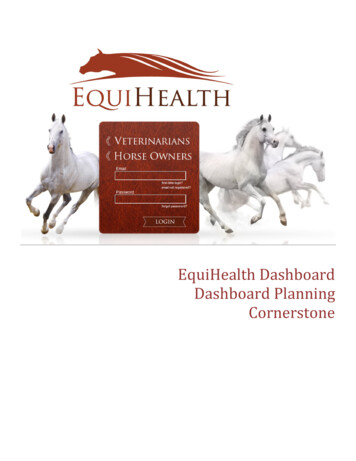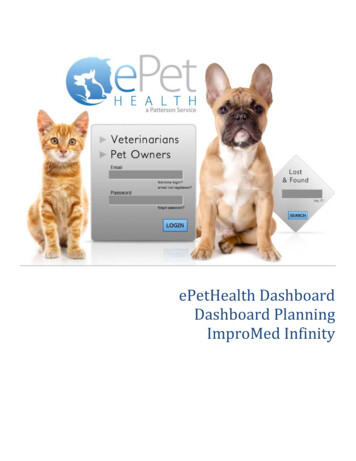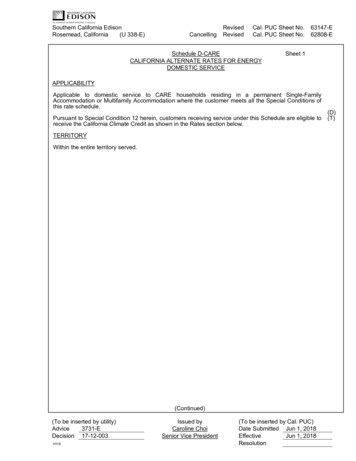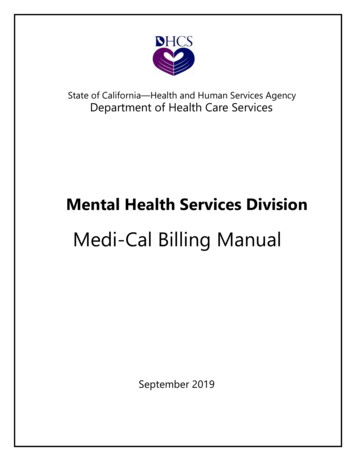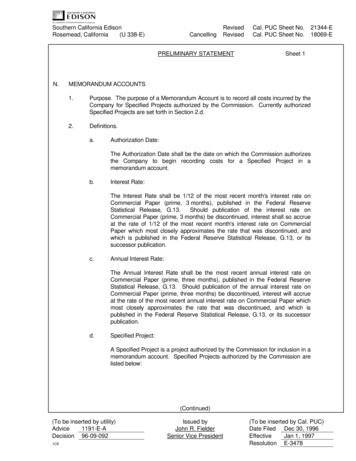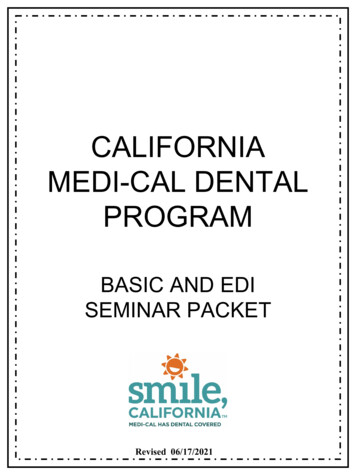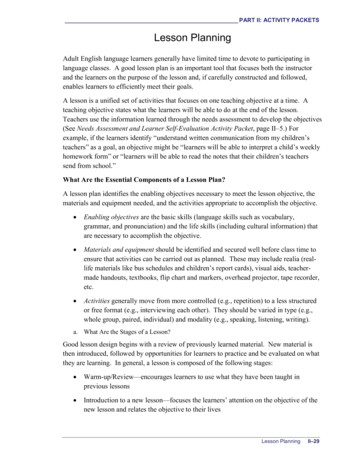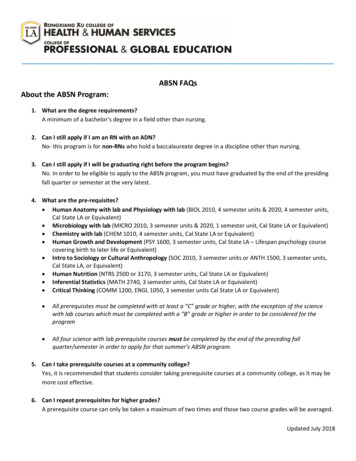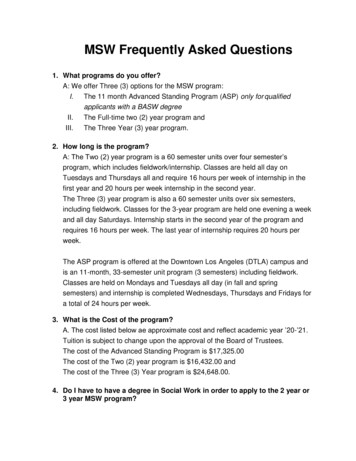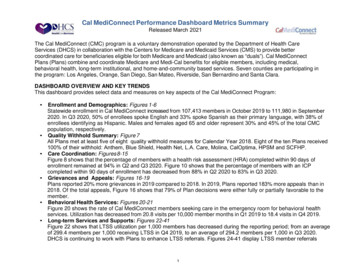
Transcription
Cal MediConnect Performance Dashboard Metrics SummaryReleased March 2021The Cal MediConnect (CMC) program is a voluntary demonstration operated by the Department of Health CareServices (DHCS) in collaboration with the Centers for Medicare and Medicaid Services (CMS) to provide bettercoordinated care for beneficiaries eligible for both Medicare and Medicaid (also known as “duals”). Cal MediConnectPlans (Plans) combine and coordinate Medicare and Medi-Cal benefits for eligible members, including medical,behavioral health, long-term institutional, and home-and-community based services. Seven counties are participating inthe program: Los Angeles, Orange, San Diego, San Mateo, Riverside, San Bernardino and Santa Clara.DASHBOARD OVERVIEW AND KEY TRENDSThis dashboard provides select data and measures on key aspects of the Cal MediConnect Program: Enrollment and Demographics: Figures 1-6Statewide enrollment in Cal MediConnect increased from 107,413 members in October 2019 to 111,980 in September2020. In Q3 2020, 50% of enrollees spoke English and 33% spoke Spanish as their primary language, with 38% ofenrollees identifying as Hispanic. Males and females aged 65 and older represent 30% and 45% of the total CMCpopulation, respectively.Quality Withhold Summary: Figure 7All Plans met at least five of eight quality withhold measures for Calendar Year 2018. Eight of the ten Plans received100% of their withhold: Anthem, Blue Shield, Health Net, L.A. Care, Molina, CalOptima, HPSM and SCFHP.Care Coordination: Figures 8-15Figure 8 shows that the percentage of members with a health risk assessment (HRA) completed within 90 days ofenrollment remained at 94% in Q2 and Q3 2020. Figure 10 shows that the percentage of members with an ICPcompleted within 90 days of enrollment has decreased from 88% in Q2 2020 to 83% in Q3 2020.Grievances and Appeals: Figures 16-19Plans reported 20% more grievances in 2019 compared to 2018. In 2019, Plans reported 183% more appeals than in2018. Of the total appeals, Figure 16 shows that 79% of Plan decisions were either fully or partially favorable to themember.Behavioral Health Services: Figures 20-21Figure 20 shows the rate of Cal MediConnect members seeking care in the emergency room for behavioral healthservices. Utilization has decreased from 20.8 visits per 10,000 member months in Q1 2019 to 18.4 visits in Q4 2019.Long-term Services and Supports: Figures 22-41Figure 22 shows that LTSS utilization per 1,000 members has decreased during the reporting period; from an averageof 299.4 members per 1,000 receiving LTSS in Q4 2019, to an average of 294.2 members per 1,000 in Q3 2020.DHCS is continuing to work with Plans to enhance LTSS referrals. Figures 24-41 display LTSS member referrals1
Cal MediConnect Performance Dashboard Metrics SummaryReleased March 2021and utilization in five categories: In-Home Support Services (IHSS), Multipurpose SeniorServices Program (MSSP), Community-Based Adult Services (CBAS), Nursing Facility (NF) and CarePlan Options (CPO). IHSS member referral data are not included in this dashboard due to ongoingdata quality assessment.Data and Analysis Notes:The dashboard is a tool that displays a combination of quarterly and annual measures. Dashboard data are reported byplan, except for the enrollment and demographic data which are calculated on a county-basis by DHCS (moreinformation below). The dashboard presents the most current data available. Therefore, the reporting time periods foreach metric reported may vary for each release.Quarterly Rolling Statewide Average: Figures 8, 10, 20, 22, 24, 26, 28, 30, 32, 34, 36, 38 and 40. Metrics representthe entire CMC program, by calendar quarters. Current Quarter data by plan: Figures 9, 11, 23, 25, 27, 29, 31, 33, 35, 37, 39 and 41.Metrics represent the data for the most recent quarter, by plan. Annual data: Figures 7, 12, 13, 14, 15, 16, 17, 18, 19 and 21.Annual data are updated once a year and are compared to previous years that are only collected in aggregate. Updated data: Figures 1-6, Figures 8-11, and Figures 22-41 have been updated for the March 2021 release. DETAILED DASHBOARD METRICS AND TRENDSThis section of the Dashboard Metrics Summary provides a detailed explanation of the performance metrics as well as asummary of key trends.Cal MediConnect Enrollment and Demographics:Enrollment and demographic data are a point-in-time view of the Cal MediConnect population. The data come from theDHCS data warehouse and the Medi-Cal Management Information System/Decision Support System (MIS/DSS).In addition to the quarterly enrollment and demographic data reported in this dashboard, monthly Cal MediConnectenrollment data will now be available through the Medi-Cal Managed Care Enrollment Reports available e-enrollment-report2
Cal MediConnect Performance Dashboard Metrics SummaryReleased March 2021Quality Withhold MeasuresCMS and DHCS monitor Plans using quality measures relating to beneficiaries' overall experience, care coordination,fostering and support of community living, and more.1 These measures, which are required to be reported underMedicare and Medicaid, build on other required data: Healthcare Effectiveness Data and Information Set (HEDIS),Medicare Health Outcomes Survey, and Consumer Assessment of Healthcare Providers and Systems (CAHPS)Survey data.CMS and DHCS utilize reported metrics from the combined set of core and California-specific quality measures. Coremeasures are common across all states participating in duals demonstrations, and were primarily developed byCMS. California-specific measures were created through a collaborative partnership between DHCS, CMS, andpublic stakeholders.Based on their performance on a designated set of core and California-specific measures, called “quality withholdmeasures,”2 Plans may receive all or a portion of an amount withheld from their capitation payment (with theexception of Part D components), at the end of each calendar year.All quality withhold measures have benchmarks that the Plans are required to meet in order to receive some or all ofthe quality withhold payment. The Quality Withhold Summary is for Calendar Year 2018.Figure 7 shows the quality withhold measures for the calendar year 2018. Definitions of the measures included forFigure 7 are below:CW stands for “core withhold”, and in most cases, a core withhold measure corresponds with a core quality measure.CAW stands for “California withhold” and usually corresponds with a state-specific quality measure. Quality withholdmeasures may be stand-alone, or based on HEDIS, CAHPS, or other national data sources.1Coreand State-Specific Reporting tingRequirements.html2Coreand State-Specific Quality Withhold Methodology and Technical oldMethodologyandTechnicalNotes3
Cal MediConnect Performance Dashboard Metrics SummaryReleased March 2021Quality withhold measure results indicated with "*" represent measures that also utilize the gap closure targetmethodology.1 For Plans that are affected by an extreme and uncontrollable circumstance, such as a major naturaldisaster, CMS and the State remit the full quality withhold payment for the year in which the extreme anduncontrollable circumstance occurred, provided that the Plan fully reports all applicable quality withhold measures.Affected Plans are identified according to the methodology utilized for Medicare Part C and D Star Ratings for theapplicable measurement year. These Plans are denoted with “ ” on Figure 7. 1CaliforniaPlan All-Cause Readmission: The ratio of the plan’s observed readmission rate to the plan’s expectedreadmission rate. The readmission rate is based on the percent of plan members discharged from a hospitalstay who were readmitted to a hospital within 30 days, either for the same condition as their recent hospital stayor for a different reason. (CW6)Annual Flu Vaccine: Percent of plan members who got a vaccine (flu shot) prior to flu season. (CW7)Follow-Up After Hospitalization for Mental Illness: Percentage of discharges for plan members 6 years of ageand older who were hospitalized for treatment of selected mental health disorders and who had an outpatient visit,an intensive outpatient encounter or partial hospitalization with a mental health practitioner within 30 days ofdischarge. (CW8)Medication Adherence for Diabetes Medications: Percent of plan members with a prescription for diabetesmedication who fill their prescription often enough to cover 80% or more of the time they are supposed to betaking the medication. (CW12)Encounter Data: Encounter data for all services covered under the demonstration, with the exception of PDEdata, submitted timely in compliance with demonstration requirements. (CW13)Behavioral Health Shared Accountability Outcome Measure: Reduction in emergency department (ED) usefor seriously mentally ill and substance use disorder members. (California-specific measure 4.1, CAW7)Documentation of Care Goals: Members with documented discussions of care goals. (California-specificmeasure 1.6, CAW8)Interaction with Care Team: Percent of members who have a care coordinator and have at least one careteam contact during the reporting period. (California-specific measure 1.12, CAW9)Medicare-Medicaid Plan Quality Withhold Analysis Results Demonstration Year ldresultsreportcady4.pdf4
Cal MediConnect Performance Dashboard Metrics SummaryReleased March 2021Quality Withhold Trends:The latest data available show that all 10 Plans met at least five quality withhold measures for Calendar Year 2018.Eight of the ten Plans received 100% of their withhold: Anthem, Blue Shield, Health Net, L.A. Care, Molina,CalOptima, HPSM and SCFHP, four of which had their quality withhold adjusted to 100% due to an extreme anduncontrollable circumstance.Care Coordination Measures:Enhanced, person-centered care coordination is a key benefit of Cal MediConnect. The dashboard tracks differentmeasures and aspects of that benefit, from the initial health risk assessment to start the care coordination process,to the development of an individualized care plan, to care coordinators, and post-hospital discharge follow-up care. Health Risk Assessments (HRAs): An HRA is a survey tool conducted by the Plans to assess a member’scurrent health risk(s) and identifies further assessment needs such as behavioral health, substance use, chronicconditions, disabilities, functional impairments, assistance in key activities of daily living, dementia, cognitive andmental status, and the capacity to make informed decisions.o Plans must complete assessments for high-risk members within 45 days of enrollment, and for low-riskmembers within 90 days of enrollment. Information tracking 90-day HRA completion rates comes from aCore measure. Figures 8 & 9 do not include unwilling and unable to reach populations in calculations.Individualized Care Plans (ICPs): The care plan is developed by members with their interdisciplinary care teamor Plans. Engaging members in developing their own care goals and care plans is a central tenant of personcentered care. ICPs must include the member’s goals, preferences, choices, and abilities. Documentingdiscussions of care goals with members is one way to assess how Plans are engaging members in their careplanning and are monitored through multiple California-specific measures.o Plans must complete a care plan for each member within 90 days of enrollment. Information tracking90-day ICP completion rates comes from a Core measure. Figures 10 & 11 do not include unwilling andunable to reach populations in calculations. CMS-DHCS continues to work with Plans to ensure improvedICP completion rates within 90 days of enrollment.Follow-up Visits within 30 Days of Hospital Discharge: Supporting members through care transitions,particularly out of an acute hospital stay, is another measure of care coordination activities. In 2016, DHCSreleased a Dual Plan Letter on discharge planning in Cal MediConnect, and this continues to be an area of focusfor program improvements. Information comes from a California-specific measure.Care Coordinators and Interdisciplinary Care Teams (ICT): An ICT works with a member to develop,implement, and maintain an ICP. The ICT is comprised of the primary care provider and care coordinator, andother providers at the discretion of the member. Information comes from a California-specific measure.5
Cal MediConnect Performance Dashboard Metrics SummaryReleased March 2021Care Coordination Trends:Figure 8 shows that the quarterly statewide percentage of members willing to participate in a health risk assessment, andwho the Plan was able to locate, with an assessment completed within 90 days of enrollment has remained at 94% in Q2and Q3 2020. Figure 9 shows that 8 of 10 Plans are at or above the statewide average of 94% for Q3 2020 and the othertwo (Blue Shield and HPSM) are below the statewide average.Figure 10 indicates that the percentage of members with an ICP completed within 90 days of enrollment has increasedfrom 63% in Q4 2019 to 83% in Q3 2020. Figure 11 indicates that in five of the ten Plans (Anthem, Blue Shield, HealthNet,CalOptima and HPSM), the percentage of members with an ICP completed within 90 days of enrollment is below thestatewide average of 83% for Q3 2020. ICP performance will continue to be a focus of DHCS program improvements inthe coming year, including potentially enhancing or modifying the quality measures and addressing low performancethrough Plan-specific performance improvement plans.Grievances and Appeals:This dashboard includes data on the two ways Cal MediConnect beneficiaries can attempt to resolve issues with theirPlans: Grievances: Grievances are complaints or disputes members file with the Plans that are evaluated at the Planlevel expressing dissatisfaction with any aspect of the Plan’s operations, activities, or behavior. This includes, butis not limited to, the quality of care or services provided (such as wait times or inability to schedule appointments),aspects of interpersonal relationships such as rudeness of a provider or employee, or failure to respect amember’s rights. This does not include benefit determinations. Appeals: If a Plan denies, reduces, or terminates benefits or services for a member, the member can appealeither through internal processes or an external process through Medi-Cal or Medicare. Appeals can bedetermined as “adverse” (denying the member’s appeal) or partially or fully favorable to the member’s appeal.This dashboard only includes data regarding appeals determined at the Plan’s level.6
Cal MediConnect Performance Dashboard Metrics SummaryReleased March 2021Grievances and Appeals Trends*:In an effort to refine the reporting and analysis process on grievances and appeals, the following new grievancescategories were introduced in 2018: access to care, transportation, billing, and home health/personal care. Figures 16and 17 show a breakdown of a total of 18,376 grievances, by category and by Plan, filed by members in 2019. This is anincrease of 3,073 member grievances reported as compared to 2018.1 The Plans that contributed the most to theincreased grievances in 2019 compared to 2018 are L.A. Care, Anthem, CHG, and SCFHP. The most commoncomplaints were reported under the “other” category (grievances other than access to care, transportation, billing andhome health/personal care). In addition to the reporting that Plans provide to CMS and DHCS, each Plan may internallycategorize their grievances and appeals differently, which may account for some of the higher number of “other”grievances when reported through the CMS and DHCS.The number of appeals varies greatly by Plans, as well as the percentage of decisions that are adverse versuspartially or fully favorable. Figure 18 shows that a total of 9,847 appeals were filed by members in 2019, an increaseof 6,363 appeals when compared to 20181. The Plans that contributed the most to the increase in appeals in 2019compared to 2018 are Molina and Blue Shield. Figure 18 also shows that 79% of Plan decisions were either fully orpartially favorable to the member’s appeal filed in 2019. Figure 19 shows that few Plans had appeals related tomental health services.DHCS and CMS will continue to work with the Plans to better understand the trends in grievances and appeals toensure beneficiary access to services.1CalMediConnect Performance Dashboard June 2019: .pdf*Plans can show increases and decreases in grievances and appeals. Plans work to ensure accurate reporting, This display can showtheir positive efforts in this respect. Totals can reflect changes in reporting, and can not only be understood as a change in count.7
Cal MediConnect Performance Dashboard Metrics SummaryReleased March 2021Behavioral Health Emergency Room Utilization:This metric measures behavioral health-related emergency visits. A visit is comprised of a revenue code for anemergency department visit and a principal diagnosis related to behavioral health. This metric is a Core measure.Behavioral Health Emergency Room Utilization Trends:One goal for Plans is to improve the coordination of behavioral health services for their members, including betweenthe mental health and substance use disorder (SUD) treatments covered by the Plans and the specialty mentalhealth services provided by county behavioral health departments. Figure 20 shows the overall trend of CalMediConnect members seeking care in the emergency room for behavioral health services has decreased from20.8 visits per 10,000 member months in Q1 2019 to 18.4 visits per 10,000 member months in Q4 2019. Inmid-2017, Plans began to receive additional and more accurate behavioral health data that may have affected howPlans report. DHCS and CMS are monitoring the effects of this change.Long-term Services and Supports (LTSS) Utilization:A central goal of Cal MediConnect is to improve access to and coordination of long-term services and supports formembers in order to help more members live in the community. DHCS has worked closely with Plans to increasereferrals to LTSS programs, particularly home and community-based services, as well as to encourage Plans tohelp their members transition out of nursing facilities and into the community where appropriate. LTSS Utilization and Referrals: LTSS Utilization and Referrals are reported by each Plan for LTSS whichincludes In-Home Support Services (IHSS) (carved out beginning in 2018), Community-based Adult Services(CBAS), Multi-purpose Senior Services Program (MSSP) (will be carved out starting January 1, 2021),Nursing Facility Services (NF) (will be carved in to all Medi-Cal managed care health plan models typesstarting January 1, 2021) and Care Plan Options (CPO).o New CPO Template: In an effort to improve data quality, a new CPO template and instructions wereshared with the Plans. Plans started reporting on this new template as of Q3 2019.8
Cal MediConnect Performance Dashboard Metrics SummaryReleased March 2021LTSS Trends:DHCS is working with the Plans to enhance LTSS referrals, and encouraging Plans to support members intransitioning out of nursing facilities and into the community with home- and community-based LTSS, as appropriate.In 2019 in particular, the CMS-DHCS contract management teams have been working closely with the plans toreview their MSSP and CPO referral rates, and to identify best practices to ensure
The dashboard is a tool that displays a combination of quarterly and annual measures. Dashboard data are reported by . Reduction in emergency department (ED) use for seriously mentally ill and substance use disorder members.
